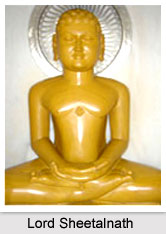 Lord Sheetalnath was the tenth Jain Tirthankara of the current age Avasarpini. As per Jain philosophy, he became a siddha, an enlightened soul which has destructed all of its karma.
Lord Sheetalnath was the tenth Jain Tirthankara of the current age Avasarpini. As per Jain philosophy, he became a siddha, an enlightened soul which has destructed all of its karma.
Lord Sheetalnath was born to Emperor Dradhrath Raja and Queen Nanda Rani at Bhaddilpur in the Ikshvaku dynasty. He was born on the twelfth day of the Magh Krishna month of the Hindu calendar. The being who later would be Lord Sheetalnath, in his former but one birth was the Emperor of Susima town in the Pushkarvar Island. Then his name was Padmottar. He was a pious and kind hearted emperor who handed his kingdom to his son when the later reached his adulthood. The emperor took Diksha or vow from Tristadha Muni. He indulged in vigorous divine practices and also travelled to far off places to worship different religious states as cited in the Holy Scriptures. This helped him in acquiring the Tirthankar-nam-and-gotra-karma. Gradually leading a religious life he completed his age and attained nirvana. He reincarnated as the Emperor of the Pranat dimension of Gods.
Resurrection of Lord Sheetalnath
Lord Sheetalnath was born on the twelfth day of the dark half of the month of Magh. When he attained adulthood he married at the request of his parents. His father, Emperor Dridhrath crowned him at the appropriate time and took diksha or vow. Sheetalnath proved to be a kind hearted and pious king who reined successfully for many years. Later Sheetalnath left his home and became an ascetic. He achieved nirvana on the fourteenth day of the dark half of the month of Paush under a Peepal tree. After wandering and preaching for a long time, he came to Sammetshikhar and achieved Nirvana on the second day of the dark half of the month of Vaishakh.
This article is a stub. You can enrich by adding more information to it. Send your Write Up to content@indianetzone.com




















